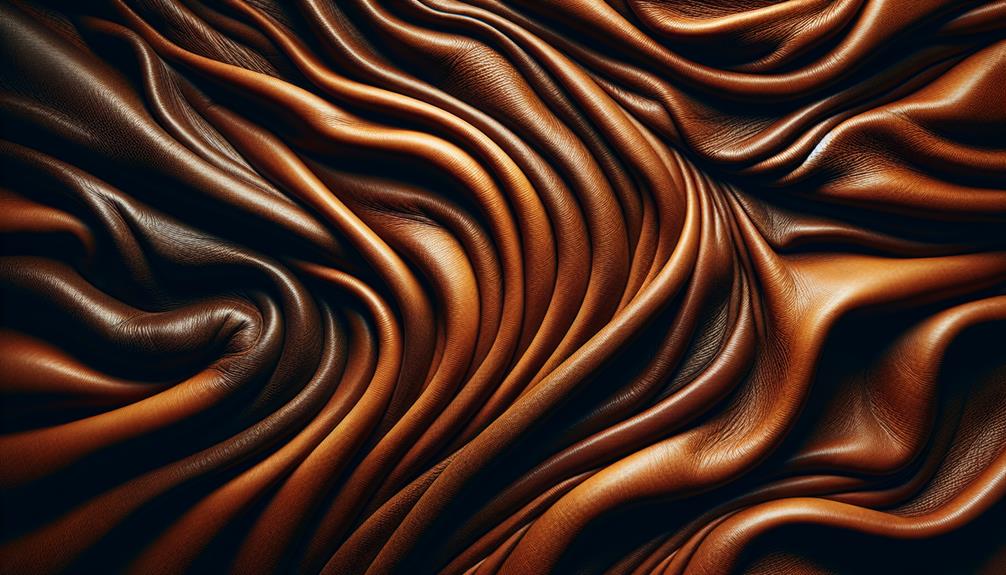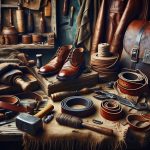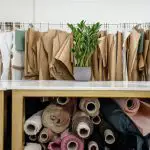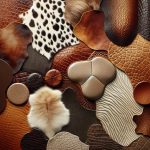I've always appreciated the unmatched quality of 100% leather, commonly known as full-grain leather. It's the real deal — no synthetic mix-ins or lower-quality layers. Full-grain leather keeps all the natural textures and markings, making each piece unique. Plus, it's super durable. That rugged leather jacket or those classy leather boots? Yeah, they probably get their toughness and luxurious look from full-grain leather. And here's a cool tip: this kind of leather actually looks better as it ages. Stick around, and I'll share more on why it's the top choice for anyone serious about great leather goods.
Table of Contents
Key Takeaways
- 100% leather is often referred to as "full-grain leather," indicating its high quality.
- Full-grain leather retains the natural grain and markings of the hide.
- It is the most durable form of leather and develops a patina over time.
- No synthetic materials are mixed in, ensuring it remains pure leather.
- Other terms like "top grain" and "genuine leather" also denote real leather but with different qualities and treatments.
Understanding 100% Leather
When we talk about 100% leather, we're referring to full-grain leather, which is the top-tier, most durable type you can get. This isn't just any leather; it's the real deal. I'm talking about genuine leather through and through, with no synthetic mix-ins. This means when you buy a product labeled as 100% leather, you're getting an item completely crafted from this high-quality material.
Now, let's clear up a common confusion: full-grain leather versus genuine leather. While these terms are often used interchangeably, there's a subtle distinction worth noting. Full-grain leather is the cream of the crop, including the entire grain layer, without any removal of the surface. Unlike other types, it keeps all the natural grain from the hide, which includes some imperfections and unique textures.
This is why full-grain leather items aren't just products; they're investments. They last incredibly long and only get better with age, developing a rich patina that makes each piece uniquely yours. Sure, it might cost a bit more upfront, but the unmatched durability and timeless look are well worth it.
Characteristics of Full-Grain Leather
Now, let's look at what sets full-grain leather apart from other types. Unlike top grain leather, which is sanded down to remove imperfections, full-grain leather keeps everything. It's the real deal—the entire, unaltered hide, complete with all its natural markings and unique characteristics. That means each piece has its own story, with scars and wrinkles that don't just add character but also testify to the leather's authenticity and quality.
What really makes full-grain stand out is its incredible durability. It's the toughest kind of leather you can get, thanks to the fact that it includes the strongest part of the hide. This type of leather can take a beating and just keeps getting better with age. It develops what's known as a patina, which is a kind of sheen formed over time due to use and exposure to the environment. It's like a badge of honor that adds to its aesthetic appeal.
Full-grain leather isn't just sturdy, it's also a symbol of luxury. You'll find it in high-end products where the maker wants to showcase the quality and craftsmanship. With proper care, items made from full-grain leather can last a lifetime, making it a top choice for anyone who values both style and substance.
Benefits of Top-Grain Leather
Top-grain leather offers a luxurious appearance while retaining the natural grain and top layer, making it a strong and durable choice for everyday use. It's the type of leather you'd want for your daily essentials, from the handbag that sees endless outings to the couch that hosts family movie nights. It's not just about looks; top-grain leather is all about quality.
The natural markings that sometimes show up on top-grain leather, like scars or insect bites, actually add a unique character to each piece. You're not just buying a product; you're getting a story. Plus, it's versatile. Almost every leather product out there, barring suede or split leather, is top-grain. This means you've probably already experienced its benefits without even realizing it.
For anyone looking to really understand what they're investing in, knowing these perks of top-grain leather can guide your decisions.
| Feature | Benefit | Ideal For |
|---|---|---|
| Luxurious Look | Enhances aesthetics | High-end products |
| Durability | Long-lasting use | Daily essentials |
| Unique Markings | Adds character | Custom luxury goods |
Durability and Quality Comparison
When we talk about leather, how long it lasts and how well it holds up against wear and tear are big deals.
Genuine leather's longevity can vary a lot, from full-grain's tough-as-nails character to bonded leather's tendency to crack and peel.
Let's look at how these different types stack up in terms of durability and quality.
Longevity of Genuine Leather
Genuine leather, especially in its full-grain form, is incredibly durable, lasting for years with proper care. If you're thinking about investing in leather, understanding its longevity is crucial. Full grain tops the list when it comes to enduring the rigors of daily use, maintaining its strength and character. Top grain isn't far behind, though; it's also quite robust and holds up well over time.
| Leather Type | Durability | Quality Maintenance |
|---|---|---|
| Full Grain | Very High | Excellent |
| Top Grain | High | Very Good |
| Other Types | Moderate | Good |
I'd say it's definitely worth choosing full grain or top grain if you want something that'll stand the test of time and even get better with age!
Leather Wear Resistance
Full-grain leather really stands out for its top-notch wear resistance and longevity, making it a prime choice for anyone after durability. If you're looking for a material that'll handle daily wear and tear and still look great years down the line, full-grain is your go-to.
Now, top-grain leather isn't far behind. It's also pretty durable and can stand up to a good deal of use. However, it's not quite as tough as full-grain.
As for split leather and bonded leather, well, they don't hold a candle to the first two. They wear out quicker and just don't offer the same quality. Knowing these differences really helps when picking out something that's meant to last.
The Tanning Process Explained
To make leather both durable and flexible, the tanning process treats animal hides using various methods. This is essential to transform the raw hides into leather that won't just decay. The tanning process also significantly affects the top layer of the leather, dictating its final texture, color, and quality.
Now, there are a few different ways to tan leather. Vegetable tanning, for example, is one of the oldest methods out there. It uses natural tannins found in plant materials like oak or chestnut trees. This method is great for producing leather that ages beautifully and develops a rich patina over time. However, it's a slow process, often taking several weeks to complete.
On the other hand, chrome tanning uses chromium salts and is much faster. It can be done in about a day and results in a leather that's softer and more flexible than vegetable-tanned leather. This type of leather is particularly popular for making garments and upholstery due to its pliability.
Each tanning method brings something different to the table, influencing not just the leather's durability but also its aesthetic appeal and how it feels to the touch.
Care Tips for Leather Products
Caring for your leather products properly ensures they last longer and stay looking great. I've learned a few key tips over the years that really make a difference, especially when you're dealing with quality leather.
First things first, I always use a leather cleaner specifically designed for leather items. This helps maintain the integrity of the top layer without harsh chemicals that can strip away natural oils.
I also make it a habit to apply a leather conditioner regularly. This step is crucial because it keeps the leather moisturized, preventing it from drying out and cracking. Think of it like using lotion on your skin—it's all about keeping that suppleness intact.
When I'm not using my leather goods, I store them in a cool, dry place. Direct sunlight is a big no-no as it can cause fading and even more cracking. I learned this the hard way with my favorite leather jacket!
Lastly, I always use a soft cloth or a soft brush to gently remove any surface dirt or dust. It's a simple step, but it keeps my leather looking fresh and ready for any occasion. Trust me, a little care goes a long way with leather!
Common Uses of Full-Grain Leather
So, let's talk about where you mostly see full-grain leather being used.
It's the go-to material for high-end fashion accessories like those fancy bags and designer belts.
You'll also find it in durable furniture upholstery and tough outdoor gear, thanks to its strength and how well it holds up over time.
High-End Fashion Accessories
Why do high-end fashion brands often choose full-grain leather for their accessories? Well, it's all about the unbeatable quality and the luxe vibe it brings. Full-grain leather isn't just any material; it's the real MVP of luxury brands, giving products like handbags, belts, and wallets that premium, long-lasting edge. Over time, it develops a patina that just adds to its charm—a sign of real, well-loved leather.
Here's a quick look at some common uses of full-grain leather in high-end accessories:
| Accessory | Benefits of Full-Grain Leather | Why Luxury Brands Love It |
|---|---|---|
| Handbags | Durable, ages well | Exudes sophistication |
| Belts | Strong, retains shape | Enhances brand prestige |
| Wallets | Resistant to wear and tear | Symbolizes craftsmanship |
| Shoes | Comfortable with use | Represents timeless style |
| Watch Straps | Flexible, long-lasting | Adds exclusivity |
Choosing full-grain leather means betting on beauty that lasts.
Durable Furniture Upholstery
Full-grain leather's durability and aesthetic appeal make it a top choice for high-end furniture upholstery. When you're looking for furniture that not only looks classy but also lasts, full-grain leather is the way to go. This type of leather keeps its strength over the years and develops a rich patina that adds character.
I've noticed that pieces made with full-grain leather bring a luxurious touch to any room. The natural textures and robust quality of this leather mean that your sofas and chairs won't just be comfortable—they'll stand the test of time. It's a smart pick if you're into furniture that gets better with age and stands up to daily life's wear and tear.
Outdoor Gear Manufacturing
Moving from indoor furniture to the great outdoors, full-grain leather proves invaluable in crafting rugged gear like hiking boots and backpacks. The durability and natural toughness of full-grain leather make it perfect for items that have to endure tough conditions. I've seen how well it holds up on my own gear, and it's impressive.
Here's why outdoor enthusiasts swear by full-grain leather:
- Hiking Boots: They take a beating on trails but manage to keep feet protected and comfortable.
- Backpacks: Strong enough to handle heavy loads and resist tearing.
- Camping Equipment: Adds a layer of durability and weather resistance that's crucial in the wild.
Top-Grain Leather in Fashion
Top-grain leather, known for its smooth finish, is a popular choice among fashion designers for crafting luxury items like handbags and shoes. This type of leather is made by sanding off the natural top layer, which gets rid of imperfections and gives it a more uniform look. That's why it's so perfect for high-end fashion where every detail matters.
What I've noticed is that top-grain leather isn't just about looks; it's incredibly durable too. This makes it ideal for everyday items that need to withstand a bit of wear and tear, like belts and stylish boots. Fashion designers love it because it's so versatile—it can look effortlessly chic or be dressed up for more formal occasions.
Having used various materials in my fashion projects, I've found that top-grain leather holds up really well over time. It doesn't crack or peel easily, which is a huge plus when you're investing in a piece that you want to last. It's this blend of durability and style that really sets top-grain leather apart in the fashion world. It's no wonder it's a staple in both men's and women's fashion collections!
Environmental Impact of Leather Production
So, let's talk about how making leather affects our planet.
It's not just about using a lot of water; there are also big worries about chemicals polluting our rivers and lakes.
Plus, turning land into farms for cattle can mean less space for wildlife.
Water Resource Depletion
Leather production guzzles a massive amount of water, with about 2,800 gallons needed just to produce one cowhide. This staggering figure really puts into perspective how water-intensive the making of real leather is. It's not just about the large volume used; it's also about how this contributes to water scarcity, especially in regions where water is already a scarce resource.
Here's a quick breakdown:
- Tanning requires tons of water, soaking the hides to prep them for processing.
- Water scarcity becomes a pressing issue as tanneries deplete local water resources.
- Community impact is significant, as local populations may struggle with reduced water availability.
It's clear, the thirst for leather has far-reaching effects.
Chemical Pollution Concerns
Tanning processes in leather production dump harmful chemicals into our environment, causing serious pollution issues. It's not just about the nasty smell; these chemicals, like chromium, can wreak havoc on our water systems and even affect our health. It's pretty alarming when you think about how these toxins could be messing up aquatic life and possibly seeping into what we drink!
| Chemical | Impact on Environment | Impact on Health |
|---|---|---|
| Chromium | Water pollution | Skin irritation |
| Dyes | Ecosystem disruption | Allergic reactions |
| Formaldehyde | Air quality degradation | Respiratory issues |
I'm all for leather, but knowing there's a cleaner way to produce it, like vegetable tanning, gives me hope. We've got to push for these better methods. It's about time we demand more sustainable practices in leather production!
Wildlife Habitat Loss
Amid the vast consequences of leather production, the loss of wildlife habitats stands out as particularly devastating. When we delve into the leather vs. animal hide debate, it's crucial to recognize how our choices affect ecosystems.
Here's what's happening:
- Deforestation for Grazing: Large swathes of forest are cleared for cattle, the primary source of leather, devastating habitats for creatures like jaguars and sloths.
- Biodiversity Loss: As these habitats disappear, the incredible variety of life within them vanishes too, leading to a poorer ecosystem.
- Threat to Endangered Species: Activities in critical areas like the Amazon push species towards extinction.
Opting for sustainable leather or alternatives can significantly lessen our impact on these vital natural environments.
How to Identify Genuine Leather
To spot genuine leather, first check if the label indicates it's '100% leather,' 'full-grain,' 'top grain,' or 'genuine leather.' These terms are your first clue in identifying quality leather goods. Labels are crucial as they tell you exactly what you're dealing with.
Next, take a good look at the leather itself. Genuine leather, especially full-grain and top grain, often features natural imperfections. These can be small scars or slight variations in texture and color. This isn't a flaw; actually, it's a good sign! It shows the leather hasn't been overly processed to remove its natural character.
Feel the texture too. Genuine leather doesn't feel overly smooth or plastic-like; it has a certain ruggedness. And if you bend the leather, watch for how it reacts. Real leather usually wrinkles under pressure, unlike synthetic materials that might simply depress or remain too rigid.
Finally, take a whiff. Real leather has a distinct, rich smell. If it smells chemical-like, it might be treated with synthetics.
| Aspect | Genuine Leather | Synthetic |
|---|---|---|
| Texture | Uneven, rugged | Smooth, even |
| Smell | Rich, natural | Chemical-like |
| Appearance | Natural imperfections | Uniform |
| Label | Clearly stated type | Vague or absent |
Understanding these characteristics will help you identify genuine leather, ensuring you get the quality you're after.
Leather Grading System Overview
Now let's look at the different grades of leather, which affect both its quality and its uses. Understanding these grades is crucial if you're aiming to master the ins and outs of leather products.
- Full-grain leather: This is the cream of the crop when it comes to leather. It includes the entire grain with minimal processing, preserving all the natural imperfections and toughness. It's the most durable and typically develops a unique patina over time, enhancing its aesthetic value. This type is top-notch for high-quality leather goods that are meant to last.
- Top-grain leather: Just a step below full-grain, top-grain leather has the very top layer slightly sanded or buffed out. This process removes imperfections for a more uniform appearance but also thins out and weakens the material slightly. It's still high quality but doesn't age as gracefully as full-grain.
- Split and bonded leather: These are on the lower end of the spectrum. Split leather, used mainly for suede, lacks the durable surface of higher grades. Bonded leather, meanwhile, is a mix of leather scraps and synthetic materials, offering a cost-effective option but with less durability and a risk of peeling.
Each grade has its place, but for those who prioritize longevity and aesthetics, grain vs. high quality is a key consideration.
Future Trends in Leather Manufacturing
The leather industry's future is increasingly focusing on sustainable and ethical manufacturing practices. We're seeing a shift towards methods that not only reduce harm to the environment but also address the ethical concerns many of us have. It's not just about the top layer of leather anymore; it's about redefining what leather can and should be.
Innovations are booming, with options like lab-grown leather and high-quality faux leather becoming more popular. These aren't your cheap, flimsy alternatives but are durable, stylish, and, most importantly, much kinder to our planet. This shift is driven by both advancing technology, like nanotechnology enhancing leather's properties, and a growing demand from consumers for cruelty-free products.
Moreover, there's a cool collaboration happening between the big names in fashion and cutting-edge biotech companies. They're teaming up to create ethical leather that feels good, looks good, and does good. Imagine wearing a jacket that's not only top-notch in style but also made without harming a single animal and with minimal environmental impact.
This isn't just a trend; it's the future. And it's a future I'm excited to be a part of, steering towards a more responsible and innovative way of producing leather.
Frequently Asked Questions
What Is High Quality Leather Called?
High quality leather is called full-grain leather. It's the best because it keeps all the natural grain, making it super strong and it ages beautifully, gaining character over time.
What Is Pure Leather Called?
I've learned that pure leather, the highest quality available, is called full-grain leather. It's durable, retains natural textures, and even gets better with age, making it perfect for luxury items.
What Are the 4 Grades of Leather?
I've learned the four grades of leather are full-grain, top-grain, genuine, and bonded. Full-grain's the best, top-grain's next, genuine covers all real leather, and bonded's made from scraps and synthetics.
What Is the Highest Level Leather?
The highest level of leather is full-grain leather. It's super durable, keeps the hide's natural marks, and gets better with age. It's the best for quality products that last a long time.
- What Are Two Positive Characteristics of Nylon? - April 19, 2024
- What Are Two Positive Characteristics of Nylon? - April 19, 2024
- Is Nylon Absorbent? - April 19, 2024








